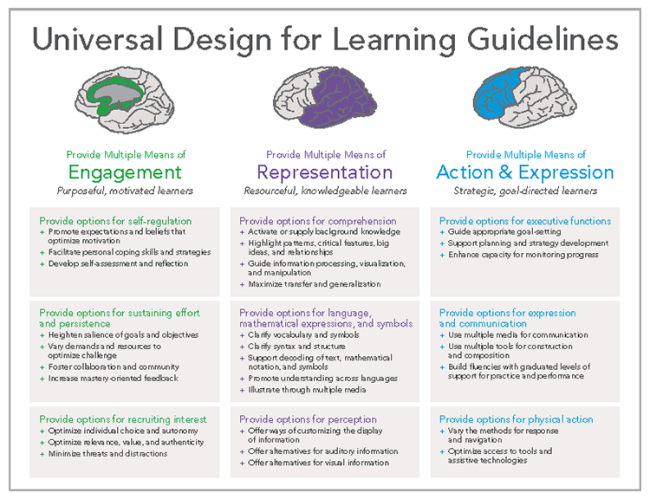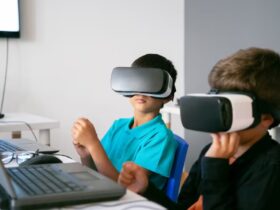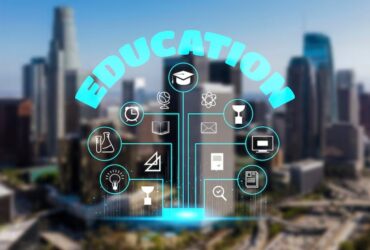Universal Design for Learning was created by David Rose, Anne Meyer, and their colleagues. They developed UDL in the 1990s.
Welcome to the world of Universal Design for Learning (UDL), a framework that aims to make education more inclusive and accessible for all learners. Created by David Rose, Anne Meyer, and their colleagues in the 1990s, UDL has gained prominence in the field of education for its innovative approach to curriculum design.
By providing diverse and flexible learning options, UDL seeks to address the individual needs of every student, regardless of their learning differences. This blog will delve into the principles of UDL, its benefits, and how it is transforming traditional teaching methods to create a more equitable learning environment for all.
The Genesis Of Universal Design For Learning
In order to understand the origins of Universal Design for Learning (UDL), it is essential to explore the early concepts and influences that paved the way for its development. Additionally, the role of neuroscience in the formation of UDL cannot be underestimated. Let’s delve into these aspects further.
Early Concepts And Influences
The concept of Universal Design, which emphasizes creating products and environments accessible to all individuals, was initially developed in architecture and later expanded to other fields. The principles of Universal Design sought to eliminate barriers and ensure inclusivity for people with disabilities.
These principles, such as equitable use, flexibility, and simple and intuitive design, were later adapted to the field of education. The idea of providing multiple means of representation, expression, and engagement to cater to diverse learners gained momentum and laid the foundation for Universal Design for Learning.
The Role Of Neuroscience In UDL Formation
Neuroscience has significantly contributed to the evolution and understanding of Universal Design for Learning. Advances in brain research have shed light on how individuals process information and learn differently. This knowledge has been instrumental in shaping the UDL framework, which embraces the variability of learners and aims to provide optimal learning experiences for all.
By incorporating insights from neuroscience, UDL acknowledges that learners have diverse strengths, preferences, and learning styles. It recognizes that the brain is malleable and can develop new connections and skills through targeted interventions and instructional approaches.
The incorporation of neuroscience into UDL has not only enhanced our understanding of learning but also provided evidence-based strategies to support learners’ individual needs. Teachers and educators can leverage this knowledge to create inclusive learning environments that maximize student engagement and achievement.
In conclusion, the genesis of Universal Design for Learning can be traced back to the early concepts of Universal Design and its adaptation to the field of education. The integration of neuroscience has further refined UDL, offering insights into how students learn and providing a framework to address individual differences. By embracing these principles, educators can create learning experiences that empower all learners to reach their full potential.
Key Figures Behind UDL
In the world of education, Universal Design for Learning (UDL) has revolutionized the way we approach teaching and learning. This approach recognizes the diverse needs of all learners and aims to provide equal opportunities for success. Behind the development and implementation of UDL, there are key figures who have played pivotal roles in shaping its principles and practices. Let’s explore two of these influential individuals:
David H. Rose: A Pioneer In UDL
David H. Rose is widely regarded as one of the pioneers and driving forces behind Universal Design for Learning. As a researcher, educator, and author, Rose has dedicated his career to promoting inclusive education practices. His expertise lies in the intersection of cognitive science, special education, and technology, which has been instrumental in the development of UDL.
Rose’s contributions to UDL are rooted in his belief that education should be accessible to all learners, regardless of their individual strengths and challenges. He emphasizes the importance of providing multiple means of representation, action, and expression to engage and support every student in the learning process.
With his profound knowledge and innovative thinking, Rose has influenced the design of educational materials, technologies, and environments that cater to the diverse needs of learners. His commitment to UDL has made a significant impact on educational practices, empowering educators to create inclusive learning environments that foster student success.
Anne Meyer: Co-founder And Visionary
Anne Meyer is another key figure who has played an integral role in the development of Universal Design for Learning. As a co-founder of CAST (Center for Applied Special Technology), Meyer has been instrumental in shaping the vision and implementation of UDL in educational settings.
Meyer’s passion for UDL stems from her belief that all learners deserve equal opportunities to thrive academically. She has been a driving force in advocating for the principles of UDL, which aim to remove barriers and create inclusive learning experiences.
Throughout her career, Meyer has worked closely with educators, researchers, and policymakers to promote the adoption of UDL practices. Her collaborative efforts have led to the development of practical strategies, tools, and resources that empower teachers to implement UDL principles effectively.
Meyer’s vision for UDL extends beyond the classroom. She envisions a society where all individuals, regardless of their abilities, can actively participate and contribute to their communities. Her unwavering dedication to UDL has paved the way for inclusive education and has inspired countless educators to embrace the principles of UDL in their teaching practices.
Cast: The Birthplace Of UDL
CAST: The Birthplace of UDL is where Universal Design for Learning was created by a team of researchers led by David Rose and Anne Meyer. They developed the framework to cater to diverse learning needs, promoting inclusive education practices globally.
CAST: The Birthplace of UDL
CAST (Center for Applied Special Technology) is a nonprofit research and development organization that is the birthplace of Universal Design for Learning (UDL). CAST’s mission is to create inclusive learning environments that provide all individuals with equal opportunities to learn. CAST was founded in 1984 by a group of educators, researchers, and entrepreneurs who shared the belief that technology could provide new opportunities for people with disabilities.
The Foundation and Mission of CAST
CAST’s foundation is built on the belief that every person has unique strengths, challenges, and interests. CAST’s mission is to design and develop tools and strategies that can help learners access, participate, and progress in the learning process. CAST’s vision is to create a world where learning is accessible, engaging, and effective for all learners.
Milestones in the Evolution of CAST
CAST has achieved several milestones in the evolution of UDL. Here are some significant moments in the history of CAST:
1. In 1999, CAST published the first edition of Universal Design for Learning: Guidelines for Accessible Curriculum Design, which provided a framework for designing inclusive learning environments.
2. In 2003, CAST launched the first version of UDL Studio, an online authoring tool that allows users to create accessible digital content.
3. In 2011, CAST released the UDL Guidelines 2.0, which updated the original guidelines and provided more detailed guidance on how to implement UDL.
4. In 2015, CAST launched the UDL Implementation and Research Network (UDL-IRN), which is a community of practice that promotes the implementation and research of UDL.
5. In 2018, CAST released the UDL Guidelines 2.2, which further refined the guidelines and provided more specific examples of how to implement UDL.
In conclusion, CAST is the birthplace of UDL and has played a significant role in the evolution of UDL. CAST’s foundation and mission are based on creating inclusive learning environments that provide all learners with equal opportunities to learn. The milestones in the evolution of CAST demonstrate the organization’s commitment to designing and developing tools and strategies that can help learners access, participate, and progress in the learning process.

Credit: inclusive.tki.org.nz
Legislation And UDL
Legislation and UDL have played a crucial role in the development and implementation of Universal Design for Learning (UDL) principles. The incorporation of UDL into federal law has had a significant impact on educational standards, shaping the way learning environments accommodate diverse student needs.
Incorporation Into Federal Law
The concept of Universal Design for Learning was first introduced in the 1997 reauthorization of the Individuals with Disabilities Education Act (IDEA). This marked a pivotal moment, as UDL principles were formally recognized and integrated into federal legislation, emphasizing the importance of providing all students with equitable access to education.
The Impact On Educational Standards
With UDL being incorporated into federal law, educational standards have experienced a notable shift towards inclusivity and accessibility. The UDL framework has prompted educators to proactively address the diverse learning needs of students, fostering an environment that promotes equal opportunities for academic success.
Principles That Shaped UDL
Multiple Means Of Representation
The concept of Universal Design for Learning (UDL) was created by a team of researchers at the Center for Applied Special Technology (CAST) in the 1990s.
The principles that shaped UDL focus on providing multiple means of representation, action and expression, and engagement to accommodate the diverse needs of all learners.
Multiple Means Of Action And Expression
The UDL framework emphasizes the importance of offering multiple means of action and expression to allow students to demonstrate their knowledge and skills in various ways.
This principle encourages educators to provide options for how students can interact with learning materials and express their understanding.
Multiple Means Of Engagement
In line with the UDL framework, multiple means of engagement seek to address the variability in learners’ interests, challenges, and preferences.
This principle encourages educators to provide options for engaging students’ curiosity, motivation, and persistence in learning.
UDL In Practice
Universal Design for Learning (UDL) is a framework that aims to make education more inclusive and accessible to all learners, regardless of their abilities or learning styles. UDL provides educators with a set of principles and guidelines to design flexible and engaging learning experiences that meet the diverse needs of students. In practice, UDL has shown great promise in transforming classrooms and creating inclusive environments where every student can thrive.
Success Stories From Classrooms
Implementing UDL in classrooms has led to numerous success stories, where teachers have witnessed the positive impact of this approach on student learning and engagement. Here are some examples:
- Improved Academic Performance: UDL allows students to access information and demonstrate their understanding in various ways. This flexibility has resulted in improved academic performance, as students can choose the methods that work best for them.
- Enhanced Motivation and Engagement: By providing multiple means of representation, action, and expression, UDL has increased student motivation and engagement. Students feel empowered and take ownership of their learning, leading to a more positive and active classroom environment.
- Personalized Learning: UDL enables teachers to differentiate instruction based on individual student needs. By offering multiple options for students to access and process information, teachers can personalize learning experiences, ensuring that every student can succeed.
Challenges And Solutions In Implementation
While implementing UDL can be transformative, it also comes with its own set of challenges. However, with careful planning and support, these challenges can be overcome. Here are some common challenges and their solutions:
| Challenges | Solutions |
|---|---|
| Lack of Awareness and Training | Provide professional development opportunities for educators to familiarize themselves with UDL principles and strategies. |
| Resistance to Change | Engage in open communication and collaboration with teachers, emphasizing the benefits of UDL and addressing concerns. |
| Access to Resources and Technology | Secure funding and resources to ensure that all students have access to the necessary tools and technologies to support UDL implementation. |
| Time Constraints | Allocate dedicated time for planning and collaboration to allow teachers to effectively implement UDL strategies. |
By addressing these challenges and implementing UDL effectively, educators can create inclusive learning environments that support the diverse needs of all learners.

Credit: www.insidehighered.com
Frequently Asked Questions
Q1. What Is Universal Design For Learning?
Universal Design for Learning (UDL) is a framework that helps educators create flexible learning environments that accommodate individual learning differences.
Q2. Why Was Universal Design For Learning Created?
UDL was created to ensure that all learners have access to high-quality education by providing flexible learning experiences that can be customized to meet their individual needs.
Q3. Who Benefits From Universal Design For Learning?
UDL benefits all learners, including those with disabilities and those who speak languages other than English. It also benefits educators by providing them with a framework for creating inclusive learning environments.
Q4. How Does Universal Design For Learning Work?
UDL works by providing educators with a framework for designing flexible learning environments that can be customized to meet the needs of individual learners. It involves providing multiple means of representation, expression, and engagement.
Q5. What Are The Key Principles Of Universal Design For Learning?
The key principles of UDL include providing multiple means of representation, expression, and engagement. It also involves creating a supportive learning environment that fosters collaboration and community.
Conclusion
The creation of Universal Design for Learning is attributed to multiple pioneers. Their collaborative efforts have shaped an inclusive approach to education. By understanding its origins, we gain insight into the importance of UDL in enhancing learning experiences for all students.












































Leave a Reply